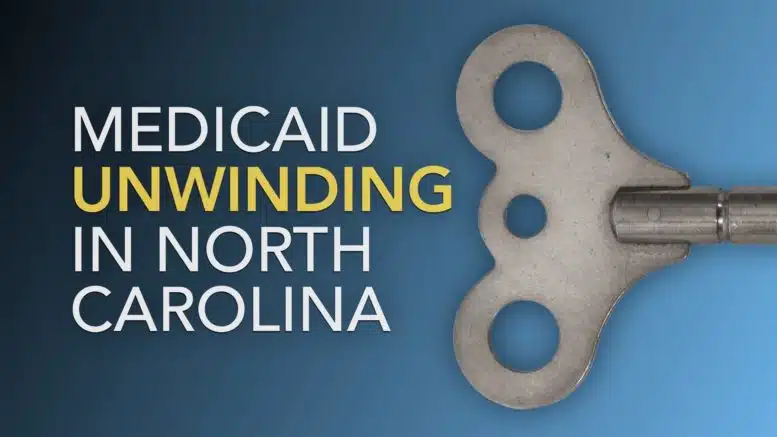By Jaymie Baxley
The expiration of a pandemic-era federal provision that prevented states from kicking Medicaid participants off the rolls has left North Carolina with the unprecedented challenge of reviewing the eligibility of more than 2.5 million residents.
Known as the continuous coverage requirement, the mandate allowed beneficiaries to skip the renewal process for Medicaid during the first three years of the COVID-19 pandemic. All participants, even those who no longer qualified for the program, were automatically re-enrolled, swelling the program from 2.1 million beneficiaries in March 2020 to just under 3 million people qualifying for coverage in May of this year..
That’s when the provision ended, triggering what health officials have dubbed the “unwinding” of the continuous coverage period. North Carolina began this yearlong undertaking in June, resuming terminations for the first time since March 2020.
Nearly 100,000 residents have since lost health insurance, and many more are expected to follow. Below is a look at some key findings from the past three months of unwinding-related data.
1. Paperwork issues account for most disenrollments
Of the 31,526 terminations recorded by the N.C. Department of Health and Human Services in August, a disproportionately large share involved residents who may or may not remain eligible for Medicaid.
The department reported that 27,546 people lost coverage last month for “procedural reasons.” Procedural disenrollments happen when a local or county office of the Department of Social Services is unable to independently verify a Medicaid participant’s income or household size. If the person fails to respond to a request for the missing information within 30 days, their benefits are automatically discontinued.
DHHS says the state has “made many efforts to reach beneficiaries to get their information” during the unwinding, including through letters, emails, text messages and automated phone calls. But if a beneficiary’s caseworker is using an outdated address or phone number, that person may never receive the message.
There are other reasons a person might fail to respond. If they receive a notice asking them to provide information, but it is not written in their preferred language, they may have difficulty understanding the request. If they understand the notice but are skeptical about the state’s sudden need for information after three years, they may dismiss the request as a potential scam.
Procedural disenrollments account for 87,308, or 87 percent, of the 99,925 terminations reported by DHHS since June. That ties North Carolina with Connecticut for the fifth largest share of procedural disenrollments in connection with the unwinding, according to an analysis of publicly available data from 47 states.
2. Some people who lost Medicaid would have kept it under expansion
DHHS recorded 3,980 non-procedural disenrollments — cases where people were actually determined to no longer qualify for Medicaid — last month.
Since June, at least 12,617 North Carolinans have been kicked off the rolls after being deemed ineligible for coverage. Gov. Roy Cooper and DHHS Sec. Kody Kinsley have estimated that thousands of those residents would remain eligible if not for the delayed implementation of Medicaid expansion.
Among other things, expansion will raise the state’s long-standing income limit for Medicaid eligibility – allowing, for example, a family of three with a combined income of less than $34,000 to qualify. This means that many beneficiaries who recently lost coverage because they make more money than the currently allowed amount would qualify again under expansion.
Expansion will not officially take effect until a state budget is approved, something that has been held up amid stalled negotiations between lawmakers in the General Assembly. The ongoing impasse over the spending plan has forced DHHS to adjust its timeline for implementing expansion, pushing a planned October launch to as late as next year.
3. Medicaid enrollment was on the rise before the unwinding
The state’s Medicaid population swelled throughout the pandemic, with enrollment growing steadily each month from March 2020 until May of this year.
More than 797,000 people were added to the rolls during that period, a 36 percent increase from the pre-pandemic tally. Statewide enrollment peaked at 2.97 million just before the state resumed terminations at the beginning of June.
That month, DHHS recorded a drop in enrollment for the first time in more than three years — initiating a downward trend that has continued through July and August. While eligible residents can sign up for Medicaid during the unwinding, the number of participants added over the past three months has not been enough to offset the purge of existing enrollees.
4. The majority of people are being re-enrolled
The aforementioned issues notwithstanding, most of the state’s redeterminations have resulted in residents continuing to receive Medicaid.
Disenrollments represent about 21 percent of unwinding-related outcomes reported so far by DHHS. Approximately 384,200 of the 484,125 redeterminations completed as of August ended with people being “retained in Medicaid,” according to the department.
North Carolina’s rate of renewals vs. disenrollments is among the best in the nation. In Texas, the state with the worst rate, 69 percent of redeterminations have ended with people getting kicked off Medicaid.
5. Nearly all renewals are being completed automatically
North Carolina is one of several states that have implemented a no-contact process for determining residents’ eligibility during the unwinding.
The state’s so-called “ex parte” system allows local and county DSS offices to use information pulled from online databases to confirm that beneficiaries continue to meet all the requirements for Medicaid. If a person’s information checks out, their coverage is automatically extended with no action needed on their end.
More than 381,600, or about 99 percent, of the state’s renewals have been completed this way since June. The other 2,570 renewals reported by DHHS were processed using paper forms filled out by residents.
North Carolina currently boasts the highest percentage of ex parte renewals in the country, according to an analysis by KFF, a foundation that focuses on health policy. Rhode Island, the state with the second largest share, has completed 90 percent of its renewals on an ex parte basis.








